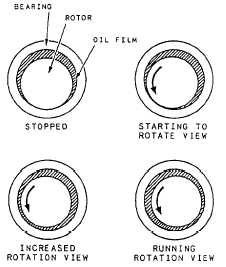wear products, so they are grease lubricated (like
automobile steering joints). These bearings are usually
fitted with a zerk fitting (grease fitting), but some may
have grease cups installed.
FUNCTIONS OF LUBRICATION
Lubrication reduces friction between moving parts
by substituting fluid friction for sliding friction. Most
lubricants are oils or greases; but other units, such as
water, can be used for lubrication. When a rotating
journal is set in motion, a wedge of oil is formed. This
wedge (layer of oil) supports the rotor and substitutes
fluid friction for sliding friction. The views shown in
figure 10-41 represent a rotor (journal) rotating in a solid
sleeve-type bearing. The clearances are exaggerated in
the drawing so you can see the formation of the oil film.
The shaded portion represents the clearance filled with
oil. While the journal is stopped, the oil is squeezed from
between the rotor and the bearing, As the rotor starts to
turn, oil adhering to the rotor surfaces is carried into the
area between the rotor and the bearing. This oil increases
the thickness of the oil film, tending to raise and support
the rotor. Thus, sliding friction has been replaced by
fluid friction.
LUBRICATING OILS AND GREASES
Many different kinds of lubricating materials are in
use, each of them filling the requirements of a particular
set of conditions. Animal and vegetable oils and even
water have good lubricating qualities, but they cannot
withstand high temperatures. Mineral oils, similar to the
oils used in an automobile engine, are the best type of
Figure 10-41.—Rotating journals in sleeve-type bearings.
lubricant for modern machinery operating at high
speeds and high temperatures.
Mineral lubricating oils are derived from crude oil
in the same process that produces gasoline, kerosene,
and fuel oil. They vary according to the type of crude oil
and the refining methods used. The same type of oil is
usually made in several grades or weights. These grades
correspond to the different weights of oil for an
automobile, varying from light to heavy.
Oils used in the Navy are divided into nine classes,
or series, depending on their use. Each type of oil has a
symbol number that indicates its class and viscosity. For
example, symbol 2190 oil is a number 2 class of oil with
a viscosity of 190 SSU. The viscosity number represents
the time in seconds that is required for 60 cubic
centimeters (cc) of oil, at a temperature of 130°F, to flow
through a standard size opening in a Saybolt
viscosimeter (fig. 10-42).
A 2190TEP oil is used for all propulsion turbines
and reduction gears. The letters TEP indicate that the
oil contains additive materials that increase its ability to
displace water from steel and inhibit oxidation.
Internal combustion engines (gasoline and diesel)
use symbol 9110, 9170, 9250, or 9500 lubricating oils.
Figure 10-42.—Viscosimeter tube.
10-49




